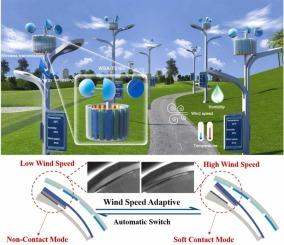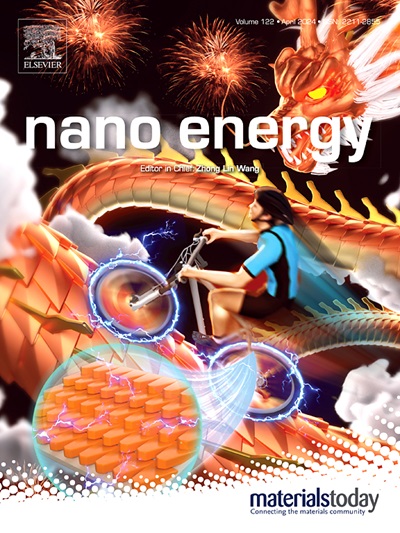Wind speed adaptive triboelectric nanogenerator with low start-up wind speed, enhanced durability and high power density via the synergistic mechanism of magnetic and centrifugal forces for intelligent street lamp system
IF 17.1
1区 材料科学
Q1 CHEMISTRY, PHYSICAL
引用次数: 0
Abstract
Minimizing start-up wind speed, reducing material wear and enhancing power density are three pivotal concerns for the TENG for harvesting wind energy. Here, a wind speed adaptive triboelectric nanogenerator (WSA-TENG) via a synergistic mechanism of magnetic and centrifugal forces is proposed. Owing to this new mechanical synergistic mechanism, WSA-TENG can operate in non-contact mode at low wind speed and in soft contact mode at high wind speed. This is significantly different from the previously reported TENGs with dual-mode automatic switching mode. As a result, WSA-TENG simultaneously achieves low start-up wind speed (1.6 m/s), enhanced durability and high power density, which enables WSA-TENG ideal for wind energy harvesting in the actual environment. WSA-TENG can achieve the maximum peak power density of 64.2 mW·m−2·m−1s at 3.3 m/s wind speed. Moreover, it can maintain 99.4 % of initial electrical output after continuous operation of 90,000 cycles. The demonstrations show that WSA-TENG can supply power to temperature/humidity sensor and transmitter to realize wireless real-time monitoring of temperature/humidity and realize wind speed monitoring through electrical signal analysis, which has great potential applications in intelligent street lamp system. This work provides a strategy for simultaneously lowing start-up wind speed, boosting durability and improving power density of TENG.

用于智能路灯系统的风速自适应三电纳米发电机,通过磁力和离心力的协同机制实现低启动风速、更耐用和高功率密度
最大限度地降低启动风速、减少材料磨损和提高功率密度是风电纳米发电机收集风能的三个关键问题。本文提出了一种通过磁力和离心力协同机制实现风速自适应的三电纳米发电机(WSA-TENG)。由于这种新的机械协同机制,WSA-TENG 可以在低风速时以非接触模式运行,在高风速时以软接触模式运行。这与之前报道的具有双模式自动切换模式的 TENG 有很大不同。因此,WSA-TENG 可同时实现低启动风速(1.6 m/s)、更高的耐用性和高功率密度,从而使 WSA-TENG 成为实际环境中理想的风能收集装置。在风速为 3.3 m/s 的情况下,WSA-TENG 的最大峰值功率密度可达 64.2 mW-m-2-m-1s。此外,在连续运行 90,000 次后,它还能保持 99.4% 的初始电力输出。演示表明,WSA-TENG 可为温湿度传感器和发射器供电,实现温湿度无线实时监测,并通过电信号分析实现风速监测,在智能路灯系统中具有巨大的应用潜力。这项工作为同时降低 TENG 的启动风速、提高耐用性和功率密度提供了一种策略。
本文章由计算机程序翻译,如有差异,请以英文原文为准。
求助全文
约1分钟内获得全文
求助全文
来源期刊

Nano Energy
CHEMISTRY, PHYSICAL-NANOSCIENCE & NANOTECHNOLOGY
CiteScore
30.30
自引率
7.40%
发文量
1207
审稿时长
23 days
期刊介绍:
Nano Energy is a multidisciplinary, rapid-publication forum of original peer-reviewed contributions on the science and engineering of nanomaterials and nanodevices used in all forms of energy harvesting, conversion, storage, utilization and policy. Through its mixture of articles, reviews, communications, research news, and information on key developments, Nano Energy provides a comprehensive coverage of this exciting and dynamic field which joins nanoscience and nanotechnology with energy science. The journal is relevant to all those who are interested in nanomaterials solutions to the energy problem.
Nano Energy publishes original experimental and theoretical research on all aspects of energy-related research which utilizes nanomaterials and nanotechnology. Manuscripts of four types are considered: review articles which inform readers of the latest research and advances in energy science; rapid communications which feature exciting research breakthroughs in the field; full-length articles which report comprehensive research developments; and news and opinions which comment on topical issues or express views on the developments in related fields.
 求助内容:
求助内容: 应助结果提醒方式:
应助结果提醒方式:


